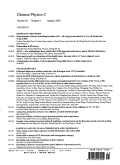- 钛学术文献服务平台 \
- 学术期刊 \
- 基础科学期刊 \
- 物理学期刊 \
- 中国物理C(英文版)期刊 \
Phase structures of neutral dense quark matter and application to strange stars
Phase structures of neutral dense quark matter and application to strange stars
基本信息来源于合作网站,原文需代理用户跳转至来源网站获取
摘要:
In the contact interaction model,the quark propagator has only one solution,namely,the chiral sym-metry breaking solution,at vanishing temperature and density in the case of physical quark mass.We generalize the condensate feedback onto the coupling strength from the 2 flavor case to the 2+1 flavor case,and find the Wigner solution appears in some regions,which enables us to tackle chiral phase transition as two-phase coexistences.At fi-nite chemical potential,we analyze the chiral phase transition in the conditions of electric charge neutrality and β equilibrium.The four chemical potentials,μu,μd,μs andμe,are constrained by three conditions,so that one inde-pendent variable remains:we choose the average quark chemical potential as the free variable.All quark masses and number densities suffer discontinuities at the phase transition point.The strange quarks appear after the phase trans-ition since the system needs more energy to produce a d-quark than an s-quark.Taking the EOS as an input,the TOV equations are solved numerically,and we show that the mass-radius relation is sensitive to the EOS.The max-imum mass of strange quark stars is not susceptible to the parameter Aq we introduced.

推荐文章
The contribution of bacteria to organic matter in coal-measure source rocks
Coal-measure source rocks
Organic matter type
Bacteria
Monomethyl alkanes
Alkyl cyclohexane
Determination of brominated diphenyl ethers in atmospheric particulate matter using selective pressu
Brominated diphenyl ethers
Atmospheric particulate matters
Selective pressurised liquid extraction
Gas chromatography-mass spectrometry
Application ontology构建及SPARQL查询研究
本体
手机应用
简单协议和RDF查询语言
查询
本体描述语言
Influence of the biological carbon pump effect on the sources and deposition of organic matter in Fu
Carbonate weathering
Hydrochemical variation
Biological carbon pump effect
Sediment trap
Autochthonous organic carbon
Carbon sink
内容分析
关键词云
关键词热度
相关文献总数
(/次)
(/年)
文献信息
| 篇名 | Phase structures of neutral dense quark matter and application to strange stars | ||
| 来源期刊 | 中国物理C(英文版) | 学科 | |
| 关键词 | |||
| 年,卷(期) | 2022,(1) | 所属期刊栏目 | NUCLEAR PHYSICS |
| 研究方向 | 页码范围 | 180-187 | |
| 页数 | 8页 | 分类号 | |
| 字数 | 语种 | 英文 | |
| DOI | 10.1088/1674-1137/ac2f95 | ||
五维指标
引文网络
引文网络
二级参考文献 (0)
共引文献 (0)
参考文献 (0)
节点文献
引证文献 (0)
同被引文献 (0)
二级引证文献 (0)
2022(0)
- 参考文献(0)
- 二级参考文献(0)
- 引证文献(0)
- 二级引证文献(0)
引文网络交叉学科
相关学者/机构
期刊影响力
中国物理C(英文版)
主办单位:
中国物理学会
中国科学院高能物理研究所
中国科学院近代物理研究所
出版周期:
月刊
ISSN:
1674-1137
CN:
11-5641/O4
开本:
出版地:
北京市玉泉路19号(乙)中国科学院高能物理研究所内 北京918信箱
邮发代号:
创刊时间:
语种:
eng
出版文献量(篇)
3629
总下载数(次)
0
总被引数(次)
2764
期刊文献
相关文献
推荐文献
- 期刊分类
- 期刊(年)
- 期刊(期)
- 期刊推荐
力学
化学
地球物理学
地质学
基础科学综合
大学学报
天文学
天文学、地球科学
数学
气象学
海洋学
物理学
生物学
生物科学
自然地理学和测绘学
自然科学总论
自然科学理论与方法
资源科学
非线性科学与系统科学
中国物理C(英文版)2022
中国物理C(英文版)2021
中国物理C(英文版)2020
中国物理C(英文版)2019
中国物理C(英文版)2018
中国物理C(英文版)2017
中国物理C(英文版)2016
中国物理C(英文版)2015
中国物理C(英文版)2014
中国物理C(英文版)2013
中国物理C(英文版)2012
中国物理C(英文版)2011
中国物理C(英文版)2010
中国物理C(英文版)2009
中国物理C(英文版)2008

 免费查重
免费查重










